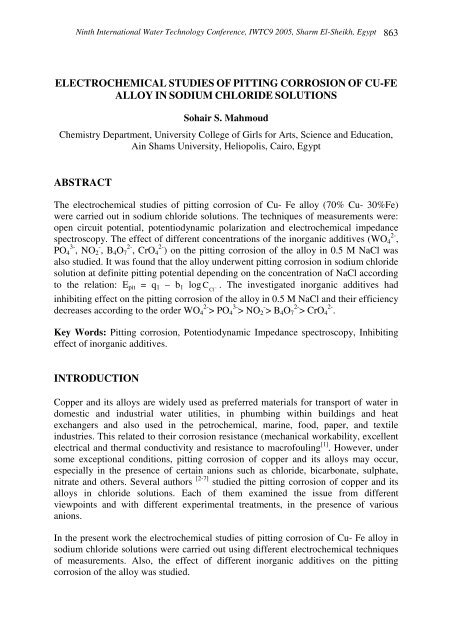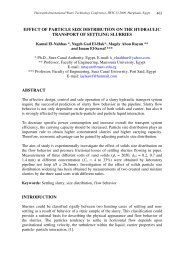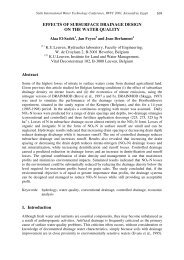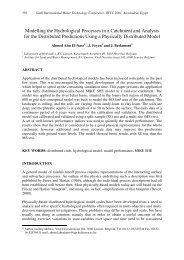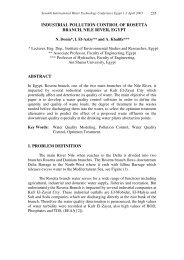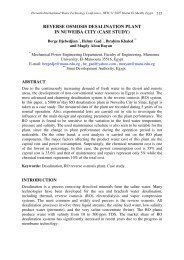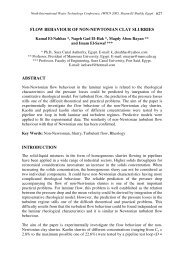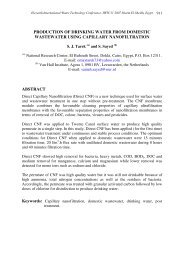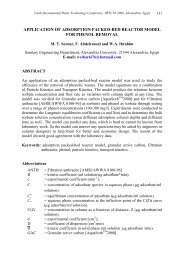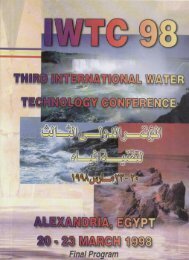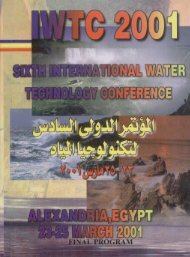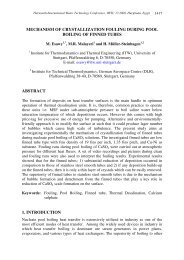ELECTROCHEMICAL STUDIES OF PITTING CORROSION ... - IWTC
ELECTROCHEMICAL STUDIES OF PITTING CORROSION ... - IWTC
ELECTROCHEMICAL STUDIES OF PITTING CORROSION ... - IWTC
You also want an ePaper? Increase the reach of your titles
YUMPU automatically turns print PDFs into web optimized ePapers that Google loves.
Ninth International Water Technology Conference, <strong>IWTC</strong>9 2005, Sharm El-Sheikh, Egypt 863<strong>ELECTROCHEMICAL</strong> <strong>STUDIES</strong> <strong>OF</strong> <strong>PITTING</strong> <strong>CORROSION</strong> <strong>OF</strong> CU-FEALLOY IN SODIUM CHLORIDE SOLUTIONSSohair S. MahmoudChemistry Department, University College of Girls for Arts, Science and Education,Ain Shams University, Heliopolis, Cairo, EgyptABSTRACTThe electrochemical studies of pitting corrosion of Cu- Fe alloy (70% Cu- 30%Fe)were carried out in sodium chloride solutions. The techniques of measurements were:open circuit potential, potentiodynamic polarization and electrochemical impedancespectroscopy. The effect of different concentrations of the inorganic additives (WO 2- 4 ,PO 3- 4 , NO - 2 , B 4 O 2- 7 , CrO 2- 4 ) on the pitting corrosion of the alloy in 0.5 M NaCl wasalso studied. It was found that the alloy underwent pitting corrosion in sodium chloridesolution at definite pitting potential depending on the concentration of NaCl accordingto the relation: E pit = q 1 – b 1 log C−Cl. The investigated inorganic additives hadinhibiting effect on the pitting corrosion of the alloy in 0.5 M NaCl and their efficiencydecreases according to the order WO 4 2- > PO 4 3- > NO 2 - > B 4 O 7 2- > CrO 4 2- .Key Words: Pitting corrosion, Potentiodynamic Impedance spectroscopy, Inhibitingeffect of inorganic additives.INTRODUCTIONCopper and its alloys are widely used as preferred materials for transport of water indomestic and industrial water utilities, in phumbing within buildings and heatexchangers and also used in the petrochemical, marine, food, paper, and textileindustries. This related to their corrosion resistance (mechanical workability, excellentelectrical and thermal conductivity and resistance to macrofouling [1] . However, undersome exceptional conditions, pitting corrosion of copper and its alloys may occur,especially in the presence of certain anions such as chloride, bicarbonate, sulphate,nitrate and others. Several authors [2-7] studied the pitting corrosion of copper and itsalloys in chloride solutions. Each of them examined the issue from differentviewpoints and with different experimental treatments, in the presence of variousanions.In the present work the electrochemical studies of pitting corrosion of Cu- Fe alloy insodium chloride solutions were carried out using different electrochemical techniquesof measurements. Also, the effect of different inorganic additives on the pittingcorrosion of the alloy was studied.
864Ninth International Water Technology Conference, <strong>IWTC</strong>9 2005, Sharm El-Sheikh, EgyptEXPERIMENTAL WORKThe investigated copper – iron alloy (70% Cu- 30% Fe) was prepared in non- ferrouslaboratory at (MRDI), Egypt. The materials were melted using crucible furnace attemperature range (100 – 1550 o C and then casted into cylindrical rods 10cm lengthand 1cm diameter. For the electrochemical measurements, the electrodes wereprepared from the casted rods. A stout copper wire lead was fixed at one end of thecylindrical electrode by mechanical jamming. The electrode was then fitted into aPyrex glass tubing of appropriate internal diameter and fixed with araldite. Just beforeuse the electrodes were mechanically polished by emery papers of different grades upto 4/0. The polished electrode were then washed thoroughly with distilled water andthen degreased by acetone.In this work the electrochemical behaviour of copper –iron alloy was studied in NaClsolutions with different concentrations. The effect of different concentrations of theinorganic additives WO 4 2- , PO 4 3- , NO 2 - , B 4 O 7 2- , and CrO 4 2- in 0.5 M HCl on the pittingcorrosion investigation the techniques of measurements were (i) open circuit potential,(ii) potentiodynamic polarization, (iii) electrochemical impedance spectroscopy. Inopen- circuit measurements the potential was measured by digital multimeter (model1008, Kyoritsu, Japan). The potentiodynamic polarization was performed at scanningrate of 1mv/ sec, using a Wenking potentioscan Type POS 73. The current density –potential curves were recorded on X-Y recorder Type PL-3. The potentials weremeasured relative to a saturated calomel electrode (SCE).The impedance measurements were carried out using impedance measurement system(1 M6 Zahner electrik Meβtechnik, Germany).RESULTS AND DISCUSSIONFigure (1) shows the corrosion potential – time plots of the investigated electrodeimmersed in different concentrations of sodium chloride solution (110 -4 – 510 -1 M)under open- circuit conditions. It is clear from these plots that on immersion of theelectrode in sodium chloride solutions the corrosion potential shifts to more negative(active) direction till reaching its steady state. The values of steady state potential forthe electrode and time required to reach it are listed in Table (1). These data indicatethat with increasing sodium concentration the more negative values of steady statepotential are obtained and longer time to reach it is required.Figure (2) represents the variation of the steady state potential, E ss , with the logarithmof NaCl concentration, log C . The plot of this figure indicate that E ss slightly shifts−Clto the more negative direction with the increase of NaCl concentration from 10 -4 to10 -3 M and greatly with the increase of NaCl concentration up to 510 -1 M. Theobtained curves contains two segments, the first one has a slope of about 20
Ninth International Water Technology Conference, <strong>IWTC</strong>9 2005, Sharm El-Sheikh, Egypt 865mV/decade and the second one with slope of about 68 mV/decade. This indicates thatthere is a relationship between the steady state potential, E ss , and logarithm of sodiumchloride concentration in the form:E ss = a – b logC −……(1)Clwhere a and b are constants, their values depends on the concentration of sodiumchloride solution.The curves of Fig.(3) show the potationdynamic anodic polarization behaviour of thealloy in NaCl solution of different concentrations from 10 -4 to 510 -1 M at a sweeprate of 1 mV/sec. It is clear from these curves that the current suddenly increases at adefinite potential in the passive region of alloy. The value of this potential depends onthe molar concentration of sodium chloride, where it shifts to the more negative (lesspositive) direction with the increase of concentration, C. The sudden increase incurrent is due to the breakdown of passivity and the initiation of pitting corrosion. Forthis reason, the potential at which the sudden increase of the current occurs is calledthe pitting potential, E pit . From the curves of Fig. (3), the values of E pit are deduced forthe different NaCl concentrations and listed in Table (2).Fig.(4) represents the dependence of the pitting potential, E pit , on the logarithmchloride ions concentration for the investigated alloy.The previous studies carried out on the pitting corrosion in NaCl media reveal thatthere is a straight line relationship between E pit and log C in the following form [8-10]E pit = a 1 – b 1 logC −……(2)Clwhere a 1 and b 1 are constants, which depend on the nature of the metal and type of theaggressive anion. The obtained curve in Fig. (4) has a segmoidal nature. The firstsegment represents a slight shift of E pit in a negative direction with a slope mV/decadewhen the concentration of chloride ions changed from 10 -4 to 10 -3 M. While, thesecond segment represents a great shift of E pit in a negative direction with a slope of123 mV/decade when the concentration of chloride ions changed from 10 -3 to 510 -1M. It can be concluded that the low concentrations of chloride ions are not sufficient todestroy completely the passivating film formed on the electrode surface, or that thepits formed are not completely active and may undergo repassivation [10-12] . At higher,concentrations of chloride ions, it can be assumed that these concentration aresufficient to destroy the passivating film formed on the alloy surface, or that the pitsformed are active and non passivatable.The effect of inorganic anions, WO 4 2- , PO 4 3- , NO 2 - , B 4 O 7 2- , CrO 4 2- , on the pittingbehaviour of the investigated alloy in 0.5 M NaCl has been studied using thepotentiodynamic and electrochemical impedance spectroscopy techniques.−Cl
866Ninth International Water Technology Conference, <strong>IWTC</strong>9 2005, Sharm El-Sheikh, EgyptFigure (5) shows the potentiodynamic anodic behaviour of the alloy in 0.5 M NaCl inpresence of different concentrations of Na 2 CrO 4 additive. Similar plots are obtainedfor the other additives, WO 4 2- , PO 4 3- , Na 2 - , B 4 O 7 2- and not shown. The different valuesof pitting potential for the alloy in presence of different concentrations of the inorganicadditives are deduced from the plots of Fig.(5) and similar ones and listed in Table (3).The results of this table indicate that the pitting potential, E pit , of the electrode shifts inthe noble direction in presence of increasing concentration of the inorganic additive.This reveals that these anions have an inhibiting effect on the pitting corrosion of thealloy in sodium chloride solutions. The dependence of E pit , in 0.5M NaCl, on theconcentration of the inhibiting anions is depicted in Fig.(6). Pitting potential, E pit ,varies linearly with the logarithm of the molar concentration of the inhibitor accordingto the following equation:E pit = a 2 + b 2 log C inh……(3)where, a 2 and b 2 are constant, their values depend on the type of inhibiting anions. Thedifferent values of a 2 and b 2 are deduced from the intercepts and slopes of the straightlines of Fig.(6), respectively. The values of a 2 are: 285, 275, 260, 215, 200 mV forWO 4 2- , PO 4 3- , NO 2 - , B 4 O 7 2- ,CrO 4 2- , respectively. While the values of b 2 are: 200,171.67, 141.67, 116.67, 83.33 mV/decade for the anions, respectively. The values ofconstants a 2 and b 2 indicate that the efficiency of pitting corrosion inhibitors decreasesaccording the order: WO 4 2- > PO 4 3- > NO 2 - > B 4 O 7 2- > CrO 4 2- .Figure (7) represents the impedance diagrams (Nyquist plots) for the workingelectrode immersed in 0.5 M NaCl solution in absence and in presence of increasingmolar concentration of Na 2 CrO 4 . Similar impedance diagrams are obtained in thepresence of other inorganic additives and not shown. The impedance diagrams ofFig.(7) and similar ones are not perfect semicircles and this difference has beenattributed to the frequency dispersion. [13,14] The charge transfer resistance (R t ) valuesare calculated from the difference in impedance at lower and higher frequencies aspreviously suggested [15-17] . To obtain the double layer capacitance (c dl ), the frequencyat which the imaginary component of the impedance is maximum, (-Z i,max ), is foundand C dl values are obtained from the equation:F (-Z i,max ) = (2π C dl R t ) -1……(4)The inhibition efficiency of pitting corrosion of the investigated alloy in 0.5 M NaClsolution in presence of inorganic additives can be calculated from the charge transferresistance (R t ), using the following equation:−1Rt− RcorrtI% =−1Rtcorrcorr(inh)−1……(5)where R tcorr and R tcorr(inh) are the charge transfer resistance values in absence and inpresence of inorganic additives, respectively. The impedance parameters derived from
Ninth International Water Technology Conference, <strong>IWTC</strong>9 2005, Sharm El-Sheikh, Egypt 867these investigations are listed in Tables (4-8) for the anions WO 4 2- , PO 4 3- , NO 2 - , B 4 O 72-, CrO 4 2- , respectively. These results indicate that as the concentration of the additiveincreases the values of R t and I% increases, but the values of C dl decreases. Thisindicates the occurrence of adsorption of the additives on the alloy surface. Theinhibition efficiency of the inorganic additives decreases according to the order: WO 42-> PO 4 3- > NO 2 - > B 4 O 7 2- > CrO 4 2 . This order is the same as that obtained bypotentiodynamic polarization measurements.The dependence of R t in 0.5 M NaCl solution, on the concentration of the inhibitinganions is depicted in Fig.(8). R t varies linearly with the logarithm of the molarinhibitor concentration according to the equation:R t = a 3 + b 3 log C inh……(6)where a 3 and b 3 are constants found to be depended on the type of the inhibitinganions. The values of a 3 and b 3 are deduced from the plots of Fig. (8). The values of a 3are found to be: 475, 275, 175, 140, 125 Ohm. Cm 2 for the anions: WO 4 2- , PO 4 3- , NO 2 - ,B 4 O 7 2- , CrO 4 2- , respectively.The values of b 3 are found to be: 373.33, 300, 208.33, 146.67, 116.67Ohm.cm 2 /decade for the anions: WO 4 2- , PO 4 3- , NO 2 - , B 4 O 7 2- , CrO 4 2- , respectively. Thismeans that the efficiency of the inorganic additives decreases according to the order:WO 4 2- > PO 4 3- > NO 2 - > B 4 O 7 2- > CrO 4 2- . This order is the same as that above mentioned.Figure (9) shows the plots of C dl versus the logarithm of the concentration of theinorganic additives. These plots indicate that, in presence of less effective anions, thereis a sharp decrease in C dl values with the increases of concentration followed by agradual decrease. While in presence of the more effective anions there is a gradualdecrease in the C dl values with the increase of inhibitor concentration.The change in the R t and C dl can be explained by the reversible competitive adsorptionbetween the inhibitive anions and aggressive Cl - ions. If inhibiting anions adsorptionpredominates on the open surface, the protective passive film formation occurs.However, if adsorption of Cl - ions predominates, pitting corrosion will occur on thesurface.The inhibiting effect of these anions can be explains by adsorption these anions whichreduces the free energy of the system and impedes the passage of the metallic ionsfrom the lattice into the solution. It must, however, kept in mind that the inhibitingproperties of these additives depend greatly on the presence of activating ions (e.g. Cl - )in solution and the ratio between these ions. Also, such behaviour of the electrode isundoubtedly associated with concurrent adsorption. The amount of adsorbed Cl -decreased when these additives are introduced into the electrolyte. For higherconcentrations of inhibiting ions the adsorption of activating ions (Cl - ions) can beexcluded completely certain definite ratios of the concentration of activating and
868Ninth International Water Technology Conference, <strong>IWTC</strong>9 2005, Sharm El-Sheikh, Egyptinhibiting ions are necessary for the passivation and protection of the alloy electrodefrom the effect of chloride ions.It is clear from the results of tables (1,2) that with increasing NaCl concentration thesteady state potential, E ss , and pitting potential shift to the more negative direction(less positive). This shift is significant at higher concentration of NaCl (C > 10 -3 M).At lower concentrations the polarization curves show anodic reactions which areessentially by the applied, potential. At such concentrations the chloride ions have alittle significant effect.The anodic reactions reveal that:Fe → Fe ++ + 2e ……(7)Cu → Cu + + e ……(8)Cu + + Cl - → CuCl ……(9)In such conditions, Cu 2 O and Fe(OH) 2 are probably formed as [18]2CuCl + H 2 O → Cu 2 O + 2H + + 2Cl - ……(10)Fe ++ + 2H 2 O → Fe(OH) 2 + 2H + ……(11)The small variation in E ss and E pit recorded at 10 -4 and 10 -3 M NaCl indicate thathealing and formation of the oxide and hydroxide probably take place simultneously.As the concentration of NaCl was further increased (C > 10 -3 M), E ss and E pit greatlyshifted to the more negative direction. The alloy tends to lose its passivity in thepresence of these high sodium chloride concentration, which may be one or more ofthe reactions. [19,20]CuCl + Cl - → CuCl 2-……(12)Cu + Cl - → CuCl + e ……(13)Cu 2 O + 2H + + 2Cl - → 2CuCl + H 2 O ……(14)Cu Cl + Cl - + 2H 2 O → CuCl 2 .2H 2 O + e - ……(15)Or the occurrence of the autocatalytic reaction as [21,22]2Cu + → Cu 2+ + Cu ……(16)
Ninth International Water Technology Conference, <strong>IWTC</strong>9 2005, Sharm El-Sheikh, Egypt 869this means that the presence of high Cl - ions concentration not only prevents theformation of the passive region but it acts in the dissolution of the alloy.In the presence of inhibiting anions the decrease in corrosion rates of the alloy may bedue to the formation of cuprous oxide, Cu 2 O, which was further oxidized to a lessprotective hydroxy chloride (paratancamite) according to the following equations [1,22-24]2CuCl 2-+ OH - → Cu 2 O + H 2 O + 4Cl - ……(17)Cu 2 O + 1/2O 2 + Cl - + 2H 2 O → Cu 2 (OH) 3 Cl + OH -……(18)2Cu + 2OH - → Cu 2 O +2H 2 O + 2e ……(19)Compounds such as Na 2 PO 4 , Na 2 B 4 O 7 which are non oxidizing agents and Na 2 WO 4and Na 2 CrO 4 of type MO 4 2- can protect metals against corrosion. Upon hydrolysis ofthese compounds, hydroxyl ions appear which are capable of forming a passivatingoxide as Fe + OH - → FeO + H 2 O with out external polarization [25] . As Cu 2 O andCu 2 (OH) 2 Cl may be formed by the above mentioned reactions (17-19).It should be mentioned that, the effect of the inhibiting anion may be also due to thespecific action of the anions themselves. For example in the presence of Na 2 PO 4 theprotective film may consist of γ-Fe 2 O 3 with FePO 4 .2H 2 O imbedded in it. Also, in thepresence of CrO 4 2- , the protective film formed on the surface of the alloy may involveCr 2 O 3 and Cr(OH) 3[26]CONCLUSIONS1- The Cu-Fe alloy undergoes pitting corrosion in high sodium chloride solutions.2- The pitting potential, E pit shifts to more negative values with the increase of themolar concentration of NaCl.3- The addition of inhibiting anions shifts the corrosion potential, E pit to the morepositive direction.4- The values of R t increases with the increase of inhibiting anions concentration, butC dl decreases.5- The inhibition efficiency of the inhibiting anions decreases according to the order:WO 4 2- > PO 4 3- > NO 2 - > B 4 O 7 2- > CrO 4 2- .
870Ninth International Water Technology Conference, <strong>IWTC</strong>9 2005, Sharm El-Sheikh, EgyptREFERENCES1- F. Mansfeld, G. Liu, H. Xiao, C. Tsai, B. Little; Corros. Sci., 36, 2036 (1994).2- M. Linder, KL Report 1987: 2, Swedish Corrosion Institute (1988).3- H. M. Shalaby, F.M. Al Kharafi, V.K. Gouda; Corrosion, 45, 536 (1989).4- F.M. Al kharafi, H.M. Shalaby, V.K. Gouda; Brit. Corros. J., 24, 284 (1989).5- M. Drogowska, L.R. Brossard, H.H. Menard, J. Electrochem. Soc., 139, 39 (1992).6- A.E. El-Meleigy, A.A. El-Warraky; Corrosion Engineering, Science andTechnology, 38, 218 (2003).7- A. El-Warraky, H.A. El-Shayeb, E.M. Sherif; Anti-Corrosion Methods andMaterials, 51, 52 (2004).8- H.C. Brookes, F.J. Graham; Corros. Sci, 45, 278 (1989).9- Z.A. Foroulis, M.J. Thubrik; Werkstoffe u korros., 25, 350 (1975).10- M. Abdallah, S.M. Abd-El-Haleem, Bull. Electrochem. 12, 449 (1996).11- S.M. Abd El-Haleem; Werkstoffe u korros, 30; 631 (1979).12- S.M, Abd El-Hallem, Brit. Corros. J., 14, 171 (1979).13- F. Mansfeld, M.W. Kending, S.Tsai, Corrosion, 37, 301 (1981).14- F. Mansfeld, M.W. Kending, S.Tsai, Corrosion, 38, 570 (1982).15- T. Tsuru, S. Haruyama; Boshoku Gijutsu, J. Japan Soc. Corros. Engng. 27, 573(1978).16- F. Bentiss, M. Lagrenee, M. Traisnel, J.C. Hornez; Corros. Sc. 41, 789 (1999).17- F. Bentiss, M. Traisnel, M. Lagrenee, Brit. Corros. J., 25, 315 (2000).18- J.N. Al-Hajji, M.R. Reda, Brit., Corros. J., 31, 125 (1996).19- S.B. Adeloju, Y.Y. Daun; Brit. Corros. J., 29, 315 (1994).20- S.B. Adeloju, Y.Y. Daun; Brit. Corros. J., 29, 309 (1994).21- A.A. El-Warraky; Material science 31, 119 (1996).22- A.A. Shams El-Din, R.A. Mohammed, H.H. Haggag; Brit. Corros. J. 35, 237(2000).23- G. Faita, G. Fiori, D.Salvadare; Corros. Sci, 15, 383 (1975).24- G. Bianchi, G. Fiori, F. Mazza; Corrosion, 34, 396 (1978).25- I.L. Rezenfeld “Corrosion inhibitors McGraw- Hill International Book company,New York (1981).26- E.Mc Cafferty, M.K. Berrett, J.S. Murd; Corros. Sci, 28, 559 (1988).
Ninth International Water Technology Conference, <strong>IWTC</strong>9 2005, Sharm El-Sheikh, Egypt 871Table (1) Data of open circuit measurements for the alloy indifferent concentrations of NaClConcentration(M)Steady- stateE ss / mVTime of steady state, T s / min110 -4 -205 35110 -3 -225 45110 -2 -300 60110 -1 -350 70510 -1 -385 85Table (2) Data of potentiodynamic anodic polarization measurements forthe alloy in different concentrations of NaClConcentration(M)Pitting corrosionE pit (mV)110 -4 +550110 -3 +525110 -2 +350110 -1 +280510 -1 +200Table (3) Data of polentiodynamic anodic polarization measurements forthe alloy in 0.5 M NaCl in presence of different concentrationsof inorganic additivesConcentrationE pit (mV)(M)-2WO 4-3PO 4-NO 2-2B 2 O 70.00 200 200 200 200 200110 -4 330 315 300 250 225110 -3 500 475 450 370 300110 -2 680 650 580 475 400110 -1 870 815 725 600 475510 -1 925 875 775 685 530CrO 4-2
874Ninth International Water Technology Conference, <strong>IWTC</strong>9 2005, Sharm El-Sheikh, Egypt
Ninth International Water Technology Conference, <strong>IWTC</strong>9 2005, Sharm El-Sheikh, Egypt 875
876Ninth International Water Technology Conference, <strong>IWTC</strong>9 2005, Sharm El-Sheikh, Egypt
Ninth International Water Technology Conference, <strong>IWTC</strong>9 2005, Sharm El-Sheikh, Egypt 877
878Ninth International Water Technology Conference, <strong>IWTC</strong>9 2005, Sharm El-Sheikh, Egypt


